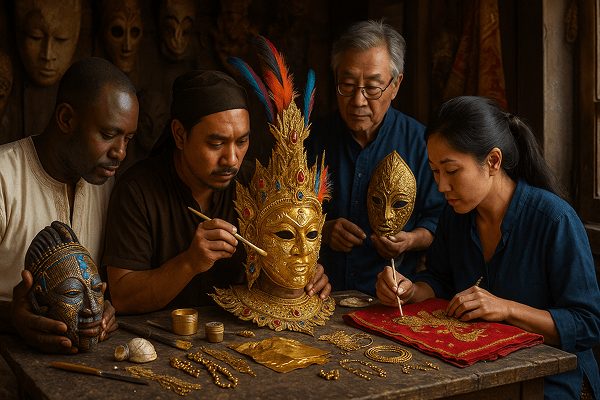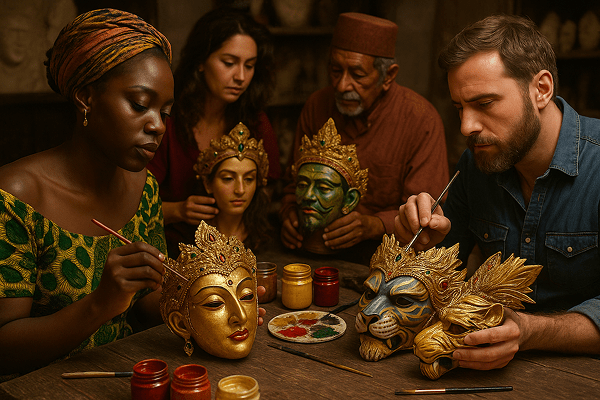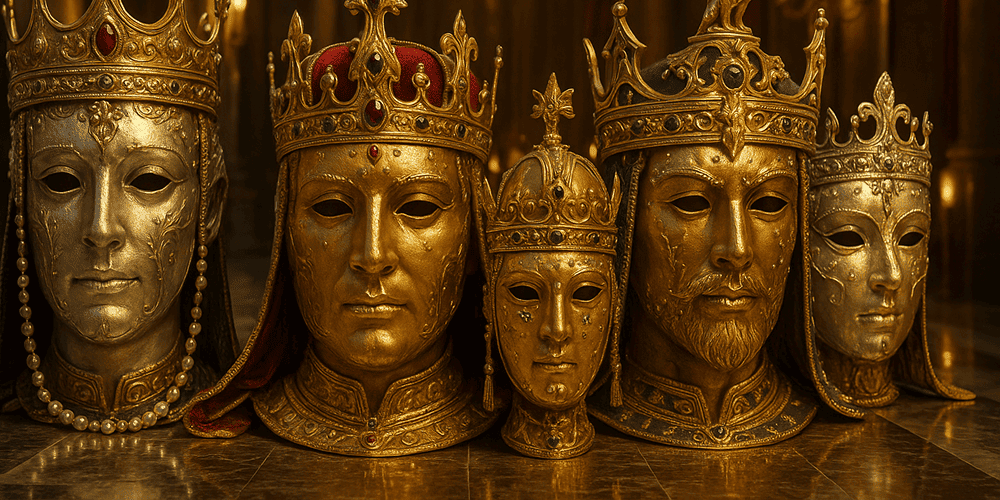Coronation Masks are among the most majestic and symbolically charged ceremonial artifacts in world history. Traditionally worn during the enthronement or inauguration of rulers — from African kings and Asian emperors to indigenous chieftains — these masks are designed to embody the sacred power, legitimacy, and ancestral connection of their wearer. Coronation Masks typically feature precious materials, intricate detailing, and motifs denoting authority, divinity, and the continuity of leadership. Most often associated with African, Southeast Asian, and Oceanic cultures, the tradition of Coronation Masks dates back centuries and continues to inspire fascination and respect in museums, rituals, and cultural heritage events.
Historical Origins of Coronation Masks
The origins of Coronation Masks can be traced to ancient societies where the act of crowning a leader was imbued with religious and political significance. The term “coronation” itself is rooted in the Latin “corona,” meaning crown — but in many cultures, the mask, not the crown, was the ultimate symbol of the ruler’s transformation. In West and Central Africa, for example, the Yoruba, Benin, and Kuba peoples created elaborate masks for kings (obas) and chiefs, often used in enthronement ceremonies. In Southeast Asia, particularly among the Javanese and Balinese, masks played a vital role in royal rituals.
Over time, the design and function of Coronation Masks evolved, reflecting shifts in political structures, religious beliefs, and artistic trends. Historical records and artifacts, such as the famed Benin ivory masks or the gold-leafed masks of ancient Burma, attest to the central role of masks in royal ceremonies. Many museums today, including the British Museum and the Musée du quai Branly, preserve these masks as key examples of ceremonial regalia.
Cultural Significance and Symbolism of Coronation Masks
Coronation Masks are deeply symbolic, representing more than mere physical disguise. In many cultures, they are believed to channel the spirit of ancestors, gods, or the nation itself. Wearing the mask during a coronation ritual enables the new ruler to assume a sacred identity, becoming a vessel for divine or ancestral power. These masks are often adorned with motifs such as sunbursts, animal totems, or geometric patterns, each carrying specific meanings of fertility, strength, wisdom, or legitimacy.
Spiritually, Coronation Masks serve as intermediaries between the human and supernatural realms. Myths and legends abound in African, Asian, and Oceanic societies — stories of kings receiving masks from ancestral spirits, or masks conferring the right to rule. Socially, the mask signals the community’s acceptance of the new leader and affirms social hierarchy. This ritual context is comparable to the use of Ceremonial Masks in other rites of passage.
Materials and Crafting Techniques of Coronation Masks
Coronation Masks are often crafted from materials signifying wealth, power, and connection to the sacred. Traditional materials include ivory, gold, bronze, rare woods, beads, shells, and fine textiles. The crafting process is highly ritualized: master artisans (often hereditary specialists) select and prepare the materials with great care, following protocols that may include prayers, offerings, or fasting.
Techniques such as carving, casting, gilding, inlay, and embroidery are used to achieve the mask’s intricate designs. Decorative elements like feathers, gemstones, and pigments enhance the mask’s visual power. Regional variations abound: West African masks may feature elaborate beadwork and metalwork, while Southeast Asian coronation masks are famed for their gold leaf and lacquer. Colors are symbolic — gold for divinity, red for vitality, white for purity, and black for mystery or ancestral power.

On toddmasks.com, you’ll find detailed guides and artisan interviews exploring the craftsmanship behind Coronation Masks.
Functions and Uses of Coronation Masks
The primary function of Coronation Masks is ritual — they are worn during enthronement ceremonies, royal processions, and public affirmations of leadership. The mask marks a moment of transformation, as the ruler symbolically becomes a conduit for ancestral or divine power. In some cultures, the mask is worn only once, while in others, it may be reused for anniversaries, funerals, or state rituals.
Beyond coronations, these masks may appear in theatrical performances, sacred dances, and festivals that commemorate the ruler’s reign. Over time, the ceremonial use of masks has transitioned into broader cultural contexts, such as national celebrations or museum exhibitions. Today, some contemporary rulers and cultural leaders incorporate Coronation Masks into modern inaugurations, blending tradition with innovation.
Regional Variations of Coronation Masks
Coronation Masks display remarkable diversity across regions. In Nigeria and Benin, ivory and bronze masks with stylized human faces are central to royal regalia. The Kuba Kingdom of Central Africa is known for its ornate wood and bead masks, used in both coronation and funerary rites. In Indonesia, the Pakubuwono coronation mask features gold leaf and intricate filigree, echoing Hindu-Buddhist iconography.
Pacific Island societies, such as those in Papua New Guinea, employ masks made from tapa cloth, shells, and feathers, each unique to the local chieftain’s lineage. Comparing Coronation Masks to other ceremonial forms, such as the Japanese Noh mask or Mesoamerican funerary masks, reveals both common themes of transformation and distinctive regional aesthetics.
Famous Examples and Notable Collections of Coronation Masks
Some of the most celebrated Coronation Masks are found in the world’s leading museums and private collections. The Benin ivory mask of Idia, now housed in the British Museum, is a masterpiece of African art and a symbol of royal power. The Musée du quai Branly in Paris and the Metropolitan Museum of Art in New York also boast extensive collections of African and Asian ceremonial regalia.
Historic coronation masks from Burma, Thailand, and Cambodia are prized for their goldwork and religious symbolism. Private collectors and royal families in Africa and Southeast Asia often preserve masks as family heirlooms, sometimes displaying them only on special occasions. For a virtual tour and expert insights, toddmasks.com features digital galleries and provenance research on key Coronation Masks.
Influence of Coronation Masks on Art and Culture
Coronation Masks have left a significant mark on art, literature, music, and design. Their forms inspire contemporary painters, sculptors, and jewelry designers, who reinterpret their motifs in new media. In literature and folklore, the coronation mask is a symbol of hidden identity, transformation, and the weight of leadership.

In film and theater, coronation masks appear in historical dramas, epics, and fantasy works, lending gravitas and cultural authenticity to royal characters. Fashion designers often incorporate mask motifs into haute couture and ceremonial wear. The ongoing interest in Coronation Masks helps preserve cultural heritage and sparks innovation in the wider world of Ceremonial Masks and ritual art.
Contemporary Status and Preservation of the Coronation Mask Tradition
Today, the tradition of Coronation Masks is maintained and revitalized by master artisans, royal families, and cultural institutions. In many regions, mask-making is taught through apprenticeships, schools, and museum workshops. Festivals, exhibitions, and heritage projects ensure that the knowledge and skills are passed to new generations.
Modern adaptations include the use of sustainable materials, digital design, and cross-cultural collaborations. Innovators blend ancient techniques with contemporary aesthetics, ensuring the tradition’s relevance. Educational resources and masterclasses, such as those promoted by toddmasks.com, encourage a new appreciation for the artistry and meaning of Coronation Masks.
Collecting and Acquiring Coronation Masks
The market for Coronation Masks is both prestigious and carefully regulated. Authentic masks are rare and often held by museums, royal families, or reputable galleries. Collectors may acquire high-quality replicas, artist interpretations, or antique pieces when provenance and ethical guidelines are clear.
Factors influencing value include material, craftsmanship, historical context, and association with notable rulers. Documentation and expert appraisal are essential for authenticity. Ethical collecting requires respect for cultural heritage, avoidance of illicit trade, and support for living artisans. Toddmasks.com offers guidance on identifying genuine Coronation Masks, understanding provenance, and making informed, responsible acquisitions.
